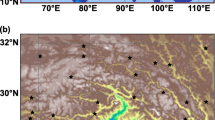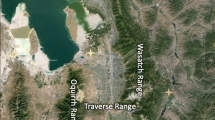Abstract
Fog and low stratus forecasting experiments have been carried out with the numerical weather prediction model ALADIN on a case of long lasting fog. The model has been used with different radiation, cloud diagnosing and horizontal diffusion schemes, different representation of orography, increased vertical resolution and with or without prognostic condensates and turbulent kinetic energy (TKE). Some of the numerical set-ups are able to reproduce the fog (low stratus) field as seen in the satellite images as well as the measured 2m temperature and relative humidity diurnal cycles. The results show that cloud diagnosing schemes and overlap assumptions play a more important role than a more sophisticated radiation scheme, or introduction of prognostic cloud water, ice, rain, snow or TKE. More realistic orography representation and a more physical horizontal diffusion scheme significantly improve the modelled low stratus and 2m temperature in the areas with variable orography.











Similar content being viewed by others
References
Bergot T, Guedalia D (1994) Numerical forecasting of radiation fog. Part I: Numerical model and sensitivity tests. Mon Weather Rev 122:1218–1230
Bergot T, Carrer D, Noilhan J, Bougeault P (2005) Improved site-specific numerical prediction of fog and low clouds: a feasibility study. Weather Forecast 20:627–646
Bergot T, Terradellas E, Cuxart J, Mira A, Liechti O, Mueller M, Nielsen NW (2007) Intercomparison of single-column numerical models for the prediction of radiation fog. J Appl Meteorol Climatol 46:504–521
Bougeault P (2001) Sub-grid scale orography parameterizations. In: Proceedings of the ECMWF seminar Key issues in the parameterization of subgrid physical processes, 3–7 September 2001, pp 53–69
Catry B, Geleyn J-F, Tudor M, Bénard P, Trojakova A (2007) Flux-conservative thermodynamic equations in a mass-weighted framework. Tellus 59A:71–79
Duynkerke PG (1991) Radiation fog: a comparison of model simulation with detailed observations. Mon Weather Rev 119:324–341
Eymet V, Dufresne JL, Ricchiazzi P, Fournier R, Blanco S (2004) Long-wave radiative analysis of cloudy scattering atmospheres using a net exchange formulation. Atmos Res 72:239–261
Geleyn J-F (1988) Interpolation of wind, temperature and humidity values from model levels to the height of measurement. Tellus 40A:347–351
Geleyn J-F, Hollingsworth A (1979) An economical analytical method for the computation of the interaction between scattering and line absorption of radiation. Beitr Phys Atmos 52:1–16
Geleyn J-F, Bénard P, Fournier R (2005a) A general-purpose extension of the Malkmus band-model average equivalent width to the case of the Voigt line profile. QJR Meteorol Soc 131:2757–2768
Geleyn J-F, Fournier R, Hello G, Pristov N (2005b) A new ‘bracketing’ technique for a flexible and economical computation of thermal radiative fluxes, scattering effects included, on the basis the Net Exchanged Rate (NER) formalism. WGNE Blue Book
Geleyn J-F, Vana F, Cedilnik J, Tudor M, Catry B (2006) An intermediate solution between diagnostic exchange coefficients and prognostic TKE methods for vertical turbulent transport. WGNE Blue Book
Geleyn J-F, Catry B, Bouteloup Y, Brožkova R (2008) A statistical approach for sedimentation inside a microphysical precipitation scheme. Tellus 60A:649–662
Guan H, Tremblay A, Isaac GA (2000) Numerical simulations of stratus clouds and their sensitivity to radiation—a RACE case study. J Appl Meteorol 39:1881–1893
Guedalia D, Bergot T (1994) Numerical forecasting of radiation fog. Part II: A comparison of model simulation with several observed fog events. Mon Weather Rev 122:1231–1246
Ivatek-Šahdan S, Tudor M (2004) Use of high-resolution dynamical adaptation in operational suite and research impact studies. Meteorol Z 13(2):1–10
Jacobs W, Nietosvaara V, Bott A, Bendix J, Cermak J, Michaelides S, Gultepe I (2008) COST-Action 722: short range forecasting methods of fog, visibility and low clouds. Available at http://137.248.191.94/fileadmin/COST_media/Official_documents/final_report_cost722.pdf
Kann A, Seidl H, Wittmann C, Haiden T (2009) Advances in predicting continental low stratus with a regional NWP model. Weather Forecast. doi:10.1175/2009WAF2222314.1
Kessler E (1969) On distribution and continuity of water substance in atmospheric circulations. Meteorol Monogr Am Meteorol Soc 10(32):84
Koračin D, Lewis J, Thompson WT, Dorman CE, Businger JA (2001) Transition of stratus into fog along the California coast: observations and modelling. J Atmos Sci 58:1714–1731
Louis J-F, Tiedke M, Geleyn J-F (1982) A short history of PBL parameterization at ECMWF. In: Proceedings from ECMWF workshop on planetary boundary layer parameterization, 25–27 November 1981, pp 59–79
Mlawer EJ, Taubman SJ, Brown PD, Iacono MJ, Clough SA (1997) Radiative transfer for inhomogeneous atmospheres: RRTM, a validated correlated-k model for the longwave. J Geophys Res 102D:16663–16682
Morcrette J-J (1989) Description of the radiation scheme in the ECMWF Model. Tech Memo 165, ECMWF, 26 pp
Pauluis O, Emanuel K (2004) Numerical instability resulting from infrequent calculation of radiative heating. Mon Weather Rev 132:673–686
Redelsperger JL, Mahé F, Carlotti P (2001) A simple and general subgrid model suitable both for surface layer and free-stream turbulence. Boundary Layer Meteorol 101(3):375–408
Remy S, Bergot T (2009) Assessing the impact of observations on a local numerical fog prediction system. QJR Meteorol Soc 135:1248–1265
Ritter B, Geleyn J-F (1992) A comprehensive radiation scheme for numerical weather prediction models with potential applications in climate simulations. Mon Weather Rev 120:303–325
Rotach MW, Zardi D (2007) On the boundary-layer structure over highly complex terrain: key finding from MAP. QJR Meteorol Soc 133:937–948
Simmons AJ, Burridge DM (1981) An energy and angular momentum conserving vertical finite-difference scheme and hybrid vertical coordinate. Mon Weather Rev 109:758–766
Teixeira J (2000) Simulation of fog with the ECMWF prognostic cloud scheme. QJR Meteorol Soc 125:529–552
Váňa F, Benard P, Geleyn J-F, Simon A, Seity Y (2008) Semi-Lagrangian advection scheme with controlled damping–an alternative way to nonlinear horizontal diffusion in a numerical weather prediction model. QJR Meteorol Soc 134:523–537
Wallace JM, Tibaldi S, Simmons AJ (1983) Reduction of systematic forecast errors in the ECMWF model through the introduction of an envelope orography. QJR Meteorol Soc 109:683–717
Xu K-M, Randall DA (1996) A semi-empirical cloudiness parameterization for use in climate models. J Atmos Sci 53:3084–3102
Zhou B, Ferrier BS (2008) Asymptotic analysis of equilibrium in radiation fog. J Appl Meteorol Climatol 47:1704–1722
Acknowledgments
The author wishes to thank wide Aladin community who introduced a variety of modular choices that can be used in the model. The author thanks Nataša Strelec Mahović for the help with choosing and interpreting the satellite images and Ivana Stiperski for proofreading the manuscript. The effort of the anonymous reviewers is gratefully acknowledged; their comments greatly improved the quality of this paper. This work is financed by the Croatian Ministry of Science through Grant 004-1193086-3036 to the Croatian Meteorological and Hydrological service.
Author information
Authors and Affiliations
Corresponding author
Appendix
Appendix
The cloud diagnosing scheme that was operational in 2004 diagnoses cloudiness using the formula
where α = 0.7, q sat is saturated specific humidity and q cs is condensed stratiform specific humidity computed as
if and 0 otherwise.In this formula, q c max is the maximum sustainable water content, β = 0.4, q is specific humidity and r c is the critical mesh averaged humidity producing a cloud.
When the model uses prognostic cloud water and ice, liquid water and ice specific contents are added to the water vapour specific humidity, so q+q l+q i is used instead of q in the equation for q cs. The alternative equation used here is
and it accounts for the presence of the prognostic condensate species.
Rights and permissions
About this article
Cite this article
Tudor, M. Impact of horizontal diffusion, radiation and cloudiness parameterization schemes on fog forecasting in valleys. Meteorol Atmos Phys 108, 57–70 (2010). https://doi.org/10.1007/s00703-010-0084-x
Received:
Accepted:
Published:
Issue Date:
DOI: https://doi.org/10.1007/s00703-010-0084-x




